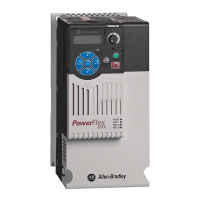Rockwell Automation Publication 520-UM001I-EN-E - July 2016 233
PID Set Up Appendix F
2. Adjust the integral gain (leave the proportional gain set as in Step 1). After
a step change in the PID Feedback:
– If the response is too slow (see Slow Response – Over Damped
on
page 233), or the PID Feedback does not become equal to the PID
Reference, decrease A462 or A474 [PID x Integ Time].
– If there is a lot of oscillation in the PID Feedback before settling out
(see Oscillation – Under Damped
on page 233), increase A462 or
A474 [PID x Integ Time].
3. At this point, the differential gain may not be needed. However, if after
determining the values for A461 or A473 [PID x Prop Gain] and A462 or
A474 [PID x Integ Time]:
– Response is still slow after a step change, increase A463 or A475 [PID x
Diff Rate].
– Response is still unstable, decrease A463 or A475 [PID x Diff Rate].
The following figures show some typical responses of the PID loop at different
points during adjustment of the PID Gains.
Unstable Response
Slow Response – Over Damped
Oscillation – Under Damped
PID Feedback
PID Reference
Time
PID Feedback
PID Reference
Time
PID Feedback
PID Reference
Time

